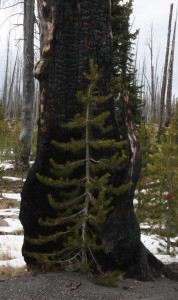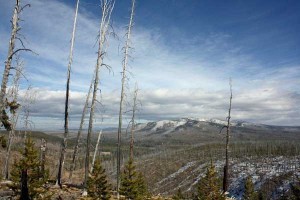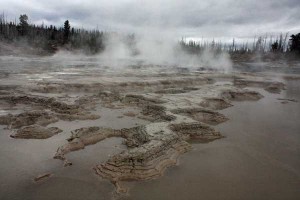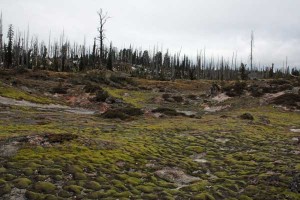Phantom Fumarole
Posted by Jim Steele on December 6th, 2008 filed in Yellowstone National ParkYou are reading what might be the first article dedicated to Phantom Fumarole on the Internet. There are very few mentions of the quirky thermal area in southern Yellowstone National Park online – in fact, my article about Union Falls, which mentions the fumarole only in passing, comes up on the first page of Google search results. In a world with a zillion articles about Old Faithful, it seems only fair that Phantom Fumarole should have a Web page too.

Phantom Fumarole is 4.5 miles from the South Entrance road via the Pitchstone Plateau trail. I’ve only been to the fumarole once, with my friend John Hebberger Jr. We were more interested in exploring the Pitchstone Plateau than seeing Phantom Fumarole. However, the fumarole proved to be much more interesting than expected, which made up for the fact that snow and weather prevented us from going as far onto the plateau as we had hoped.
View Larger Map
The name “Phantom Fumarole” doesn’t do justice to the area. By definition, a fumarole is a dry area where steam and gases emerge from the ground in a volcanic area – without a doubt, a common feature in Yellowstone. However, Phantom Fumarole had some pools of bubbling water and other pools of standing water in addition to the various gas vents. In short, it was a much more dynamic area than the name implies.
View Larger Map
However, there is a major caveat. We were at Phantom Fumarole well into the fall, when there had been plenty of precipitation and there were a few inches of snow on the surrounding terrain. As a result, there was a lot of water in the fumarole – much more than there probably is in July. This was my first trip to the fumarole, so I don’t know what it looks like in other seasons. I did find a few pictures that showed a much drier fumarole than we saw.
Regardless, it still seemed to be a more interesting area than it gets credit for. It’s a reasonably large thermal area – certainly not the Upper Geyser Basin, but much larger than the vents that periodically crop up in the parking lot at Mud Volcano. If you’re looking for a late season hike, this could be a good choice, as the peak elevation on this hike is roughly 8,500 feet. That said, this is a good hike for a seasoned explorer that wants to see a new perspective on Yellowstone. You’ll see a different side of the park than you’re used to, thanks to the volcanic soils, the unique views from the plateau, and the fumarole. But if you’re looking for your first Yellowstone day hike, there are many better choices.
This hike offers the added benefit of some serious solitude in a lightly used area of the park. The Pitchstone Plateau trail is less well defined than many – although easy to follow at least as far as the fumarole. There are campsites a mile from Phantom Fumarole and plenty of others further along the trail. Some backpackers choose to do an 18-mile traverse through the plateau, starting at the trailhead south of Lewis Falls and emerging at the Grassy Lake Reservoir along the Ashton-Flagg Ranch Road after fording the Falls River at the junction with the Union Falls trail. If you’re looking for a multi-day backpacking trip without running into the masses, this would be a fine choice. Just bring plenty of bug repellant – this is prime mosquito country.
To get to the trailhead, drive north from the south entrance of Yellowstone. The trailhead is a small parking area on the west side of the highway just a couple of miles south of Lewis Falls. It’s easy to miss – there is only enough room for a few cars at the parking lot. A large sign and a trail register are located at the trailhead.
The first phase of the hike is a fairly steep climb up the edge of the plateau. The climb begins just after the trailhead and gains about 400 feet quickly. Most of the rest of the trail is relatively level – you’ll gain roughly 400 additional feet on your way to the fumarole.
As you climb, you’ll definitely get the sense that you’re in a unique Yellowstone environment. The soil is gritty, with plenty of obsidian and other volcanic rock. It’s very interesting to note that the Pitchstone Plateau is only about 70,000 years old, so essentially everything that you’ll see on this hike is brand new in geologic terms.
Due to the gritty soils, the vegetation in this region is sparse compared to the rest of Yellowstone. Much of the forest burned in 1988, which makes for an interesting hike. It’s truly fascinating to see how much the forest has rejuvenated over the past 20 years. Some of the new trees will be taller than you are. And many of the burned trees are still standing. If you’re hiking on a windy day, the sound of the breeze blowing through the dead trees can be spooky.

The lack of vegetation enables you to enjoy some views that would otherwise have been blocked by the foliage. Near the start of the hike, you’ll be able to catch a quick glimpse of Lewis Lake and look toward the Absaroka Range. And if you hike just past Phantom Fumarole toward the campsites, you’ll see the Tetons.

After 4.5 miles, you arrive at Phantom Fumarole. It’s an interesting area. There were a few inches of snow when we visited, but we could see numerous places near the fumarole where the warmth coming through the ground had melted all of the snow.

In the middle of the fumarole, water was gushing, making the thermal area much more interesting than if we had only heard gases escaping from the earth. We were both surprised at how much water there was in the fumarole, and I’m hoping to get back there sometime in July or August next summer to see how much of a difference the late-season precipitation had made. I wouldn’t be surprised to find it bone dry in the middle of the summer.

Just behind the fumarole, we saw a patch of ground where green mosses were able to grow on the ground due to the temperature of the soils. The green, mossy ground, numerous burned trees rising behind it, and younger trees growing among the dead made for an interesting contrast.

After a lifetime of exploring the thermal areas in places like Old Faithful and the Norris Geyser Basin, it’s always a treat to get back into a backcountry thermal area like Phantom Fumarole where you can explore without restrictions. There are no boardwalks or warning signs and you won’t see many people back there, so you might get a chance to see Phantom Fumarole up close. That said, be careful – the crust is thin here, the water is hot, and you’re a long way from the highway.
After you’re done exploring the fumarole, you can continue along the Pitchstone Plateau trail or retrace your steps back to your car.
If anyone else has visited the area – particularly at different times of the year – I’d love to read about your experiences. Leave a comment or send me an email.

July 23rd, 2013 at 10:48 am
[…] and the Bechler Canyon. Or you can start visiting some of the second-tier locations, like the Phantom Fumarole, Riddle Lake or Summit […]